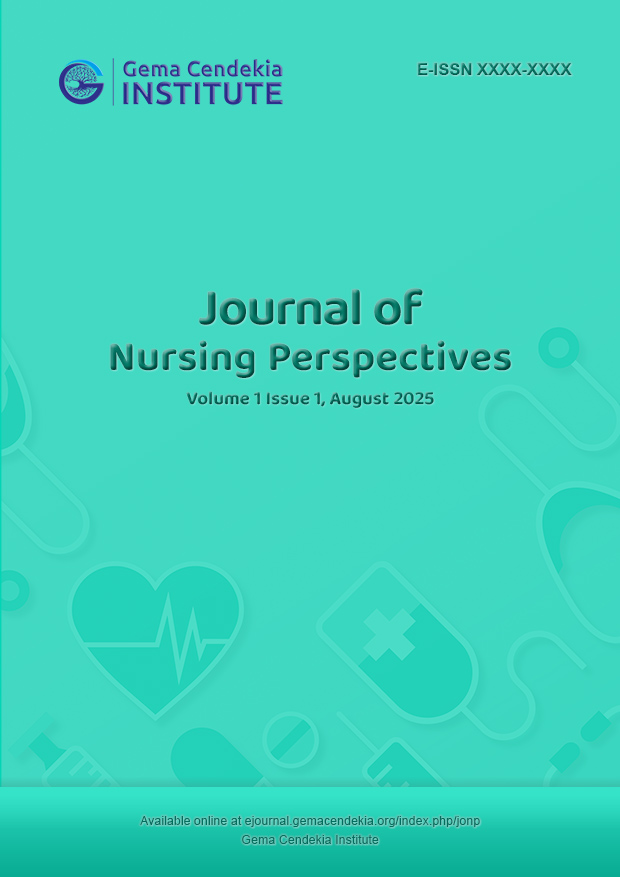Hubungan Tingkat Pengetahuan dengan Kepatuhan Minum Obat pada Pasien Tuberkulosis (TBC) di Puskesmas Kediri
Keywords:
Knowledge, Adherence, Tuberculosis (TB), Anti-Tuberculosis Drugs (OAT), NursingAbstract
Tuberculosis (TB) remains one of the major public health problems in Indonesia. The success of TB treatment largely depends on the level of patient adherence to taking anti-tuberculosis drugs (OAT) regularly and completely. However, poor adherence often becomes the main obstacle in achieving optimal recovery. One of the key factors suspected to influence adherence is the patient’s level of knowledge regarding TB and its treatment. This study aimed to analyze the relationship between knowledge level and medication adherence among TB patients undergoing treatment at the Kediri Public Health Center, West Lombok Regency. This research employed a descriptive correlational design with a cross-sectional approach. The study population consisted of all TB patients who were actively undergoing treatment during the period of January–June 2025. The sample was determined using a purposive sampling technique, resulting in 60 respondents. The instruments used were a validated and reliable questionnaire assessing knowledge about TB and the Morisky Medication Adherence Scale (MMAS-8) to measure medication adherence. Data analysis was conducted using univariate and bivariate tests, with the Chi-square test applied at a significance level of α = 0.05. The results showed that the majority of respondents had a good level of knowledge (56.7%) and a high level of adherence (61.7%). Statistical analysis revealed a significant relationship between the level of knowledge and medication adherence among TB patients (p = 0.021). These findings indicate that adequate knowledge about TB and its treatment benefits can enhance patients’ adherence to OAT therapy. The study recommends that nursing personnel strengthen continuous educational interventions through both individual and group counseling approaches to improve TB patients’ knowledge and motivation in completing their treatment regimen.
References
Abdjul, R. L., & Herlina, S. (2020). Asuhan keperawatan pada pasien dewasa dengan pneumonia: Studi kasus. Fakultas Ilmu Kesehatan, Universitas Veteran Jakarta, 6, 581–590. https://doi.org/10.31219/osf.io/2z9h6
Adane, A. A., Alene, K. A., Koye, D. N., Zeleke, B. M., & Yifru, Y. M. (2019). Non-adherence to anti-tuberculosis treatment and determinants among patients with tuberculosis in Northwest Ethiopia. PLOS ONE, 14(1), e0211936. https://doi.org/10.1371/journal.pone.0211936
Arinaminpathy, N., Batra, D., Khaparde, S., & Vassall, A. (2021). The impact of adherence to anti-tuberculosis treatment in India: A simulation study. BMC Infectious Diseases, 21(1), 876. https://doi.org/10.1186/s12879-021-06593-0
Bai, L., Wang, X., & Ma, Y. (2020). Knowledge, attitudes, and practices related to tuberculosis in Tibet, China. BMC Public Health, 20(1), 168. https://doi.org/10.1186/s12889-020-8250-5
Balogun, M., Sekoni, A., Meloni, S. T., Odukoya, O., Onajole, A., Longe-Peters, O., ... & Idigbe, E. (2020). Triggers of treatment interruption among patients with tuberculosis in Nigeria. PLOS ONE, 15(11), e0241670. https://doi.org/10.1371/journal.pone.0241670
Dini, R., & Sari, N. P. (2021). Hubungan tingkat pendidikan dengan pengetahuan pasien tuberkulosis di wilayah kerja Puskesmas. Jurnal Keperawatan Indonesia, 24(2), 113–120. https://doi.org/10.7454/jki.v24i2.891
Direktorat Pencegahan dan Pengendalian Penyakit Menular Langsung. (2023). Pedoman nasional pengendalian tuberkulosis. Jakarta: Kemenkes RI. https://tbindonesia.or.id
Gebremariam, M. K., Bjune, G. A., & Frich, J. C. (2010). Barriers and facilitators of adherence to TB treatment in patients on concomitant TB and HIV treatment: A qualitative study. BMC Public Health, 10(1), 651. https://doi.org/10.1186/1471-2458-10-651
Jaiswal, A., Singh, V., Ogden, J. A., Porter, J. D., Sharma, P. P., Sarin, R., ... & Jain, R. C. (2003). Adherence to tuberculosis treatment: Lessons from the urban setting of Delhi, India. Tropical Medicine & International Health, 8(7), 625–633. https://doi.org/10.1046/j.1365-3156.2003.01058.x
Kementerian Kesehatan Republik Indonesia. (2023). Laporan situasi tuberkulosis di Indonesia 2023. Jakarta: Kemenkes RI. https://tbindonesia.or.id
Kizub, D., Ferreira, M., Lima, S. S., et al. (2021). The impact of directly observed therapy on tuberculosis treatment adherence: A systematic review and meta-analysis. BMJ Global Health, 6(5), e005019. https://doi.org/10.1136/bmjgh-2021-005019
Kumar, A., Dewan, P., & Nair, D. (2022). Effect of patient education and counseling on adherence to tuberculosis treatment: A randomized controlled trial. Indian Journal of Tuberculosis, 69(1), 15–22. https://doi.org/10.1016/j.ijtb.2021.08.005
Liu, Q., Abba, K., Alejandria, M. M., Balanag, V. M., Lansang, M. A., & Mangura, B. T. (2018). Reminder systems to improve patient adherence to tuberculosis treatment. Cochrane Database of Systematic Reviews, 2018(8), CD006594. https://doi.org/10.1002/14651858.CD006594.pub4
Morisky, D. E., Ang, A., Krousel-Wood, M., & Ward, H. J. (2008). Predictive validity of a medication adherence measure in an outpatient setting. Journal of Clinical Hypertension, 10(5), 348–354. https://doi.org/10.1111/j.1751-7176.2008.07572.x
Nugroho, A., Wulandari, R., & Setiawan, H. (2022). Faktor-faktor yang memengaruhi kepatuhan minum obat pasien tuberkulosis paru. Jurnal Kesehatan Masyarakat Nasional, 17(1), 45–54. https://doi.org/10.21109/kesmas.v17i1.4421
Polit, D. F., & Beck, C. T. (2021). Nursing research: Generating and assessing evidence for nursing practice (11th ed.). Wolters Kluwer.
Putri, A. W., & Sari, M. P. (2021). Hubungan tingkat pengetahuan dengan kepatuhan pengobatan pada pasien tuberkulosis. Jurnal Keperawatan dan Kesehatan, 9(1), 33–41. https://doi.org/10.35451/jkk.v9i1.724
Rosenstock, I. M. (1974). The health belief model and preventive health behavior. Health Education Monographs, 2(4), 354–386. https://doi.org/10.1177/109019817400200405
Sagwa, E., Mantel-Teeuwisse, A. K., Ruswa, N., Musasa, J. P., Pal, S., & Van den Heuvel, J. (2012). Adverse events during treatment of drug-resistant tuberculosis: Incidence, type, and correlation with treatment outcome. Journal of Infectious Diseases, 206(7), 1034–1041. https://doi.org/10.1093/infdis/jis431
Saputra, M., & Hidayat, R. (2020). Tingkat kepatuhan pasien tuberkulosis paru dalam menjalani terapi obat di Puskesmas. Jurnal Ilmu Kesehatan, 8(2), 89–98. https://doi.org/10.33369/jik.v8i2.1234
Shargie, E. B., & Lindtjørn, B. (2007). Determinants of treatment adherence among smear-positive pulmonary tuberculosis patients in Southern Ethiopia. PLoS Medicine, 4(2), e37. https://doi.org/10.1371/journal.pmed.0040037
Uplekar, M., Weil, D., Lonnroth, K., Jaramillo, E., Lienhardt, C., Dias, H. M., ... & Raviglione, M. (2015). WHO’s new end TB strategy. The Lancet, 385(9979), 1799–1801. https://doi.org/10.1016/S0140-6736(15)60570-0
Wulandari, S. (2022). Pengetahuan dan motivasi pasien dalam kepatuhan terapi obat anti tuberkulosis. Jurnal Ilmu Keperawatan, 10(2), 101–110. https://doi.org/10.32584/jik.v10i2.1589
World Health Organization. (2020). Adherence to long-term therapies: Evidence for action. Geneva: WHO. https://www.who.int/chp/knowledge/publications/adherence_report/en/
World Health Organization. (2024). Global tuberculosis report 2024. Geneva: WHO. https://www.who.int/teams/global-tuberculosis-programme/tb-reports
Downloads
Published
Issue
Section
License
Copyright (c) 2025 Niswatun Fahmi (Author)

This work is licensed under a Creative Commons Attribution-ShareAlike 4.0 International License.










